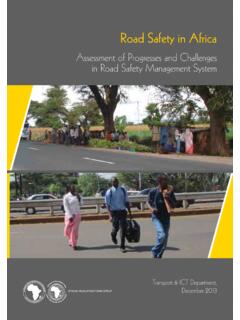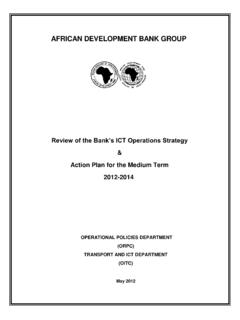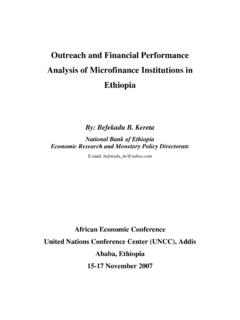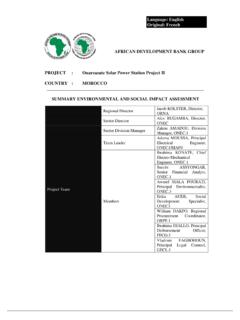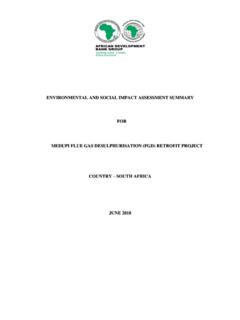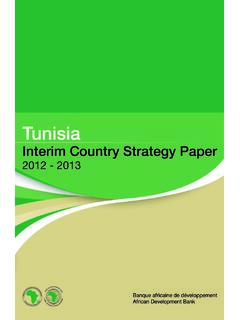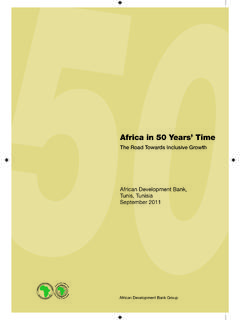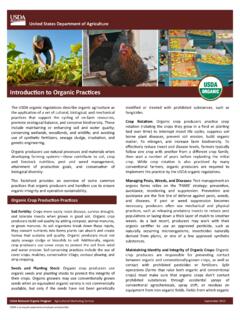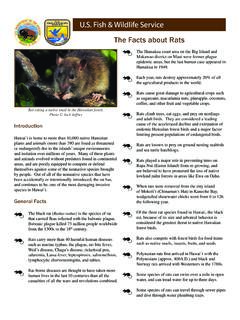Transcription of Root and Tuber Crops (Cassava, Yam, Potato and Sweet …
1 BACKGROUND PAPER root and Tuber Crops ( cassava , Yam, Potato and Sweet Potato ) Roots and Tubers Prepared by: Nteranya Sanginga, IITA Co-Conveners Adiel Mbabu, CIP i EXECUTIVE SUMMARY root and Tuber Crops , including cassava , Sweet Potato , Potato and yam are the most important food Crops for direct human consumption in Africa. These four Crops are grown in varied agro-ecologies and production systems contributing to more than 240 million tons annually, covering around 23 million hectares. The aggregate value of yam, cassava , Potato and Sweet Potato exceeds all other African staples, including cereal Crops (cereals annually producing on average 169 million tons on 108 million ha of land).
2 There are many compelling reasons for encouraging these humble root and Tuber Crops for sustainable food production in Africa: (i) they are versatile staples to address food and nutrition security and produce more food per unit area of land, compared to many other Crops ; (ii) Potato and Sweet Potato are short cycle Crops (3 to 4 months), and thus well suited to the double cropping seasons particularly the rain-fed system; (iii) yam and cassava , though longer in their cropping cycle, are vital in the annual cycle of food availability due to their broader agro-ecological adaptation, diverse maturity period and in-ground storage capability, permitting flexibility in harvesting period for sustained food availability; (iv) these Crops are also capable in efficiently converting natural resources into a more usable product, caloric energy in the growing season, which is the highest of all major arable Crops ; almost double that of wheat and rice.
3 (v) they are a cheap but nutritionally rich staple food that contributes protein, vitamin C, vitamin A, zinc, and iron to meeting the dietary demands of the region s fast-growing towns and cities; (vi) they have high demand in local and national markets; (vii) they are far less susceptible to large-scale market shocks and price speculation experienced by more widely traded staples, such as grains, during international market crises (as in the food crisis of 2007 2008). As such they contribute to a more stable food system and predictable source of income. The four Crops have common and unique challenges related to quality seed production, new variety adoption, losses due to insects and diseases, low productivity in poor soils, tolerance to stress associated with heat and drought, consumer preferences, and storage of harvested products.
4 As pressure on agricultural land increases, improved productivity of these Crops will be needed. Women play a critical role in the production of these Crops ; therefore, it is critical consider improvement of these Crops as a means to relieve gender in-equality within African agricultural systems. More general challenges in Africa impact the root and Tuber Crops more than others. The lack of research funding, limited research capacity and poor infrastructure (for research and on-farm) greatly diminishes the development of a competitive agricultural sector in Africa, and particularly for root and Tuber Crops . There are a growing number of programs of research in Africa on yam, cassava , Potato and Sweet Potato addressing genetic enhancement, seed systems, production, marketing and nutrition impacts.
5 Different approaches to improve the quality of production technologies used by smallholder farmers have been developed. New varieties were developed and distributed to farmers. Farmers were trained to produce quality seed for their own use, for local seed provision and opportunities for small-scale seed enterprises were explored. Partnerships involving both national and international actors were created to expedite access and availability of the improved technologies to African small holders. Real and potential opportunities exist to sustain and further elevate this work over the coming years. Opportunities for the root and Tuber Crops are highlighted by the tremendous growth these Crops have shown in recent years.
6 The yellow root cassava and orange-flesh Sweet Potato are excellent examples of how research can be transferred to development on a continent-wide ii scale. These Crops will all benefit from applying product development concepts into approaches for technology transfer. There is a tremendous opportunity for transferring experiences across the root and Tuber Crops . Further investment can capture the following opportunities: 1. Accelerated breeding methods and tools for the breeding of improved varieties. 2. Guidelines, technologies, diagnostic tools, and business models for improving seed systems. 3. Guidelines and technologies for sustainable intensification of production.
7 4. Models and tools for nutrition and behavior change. 5. Models, tools, and technologies for upgrading value chains. 6. Evidence base, policy options and partnership models for going to commercial scale. 7. Capacity development, both institutional and human capacity. Strategic investment would ensure effective variety development and adoption to accelerate impact of technology advances, including strengthening networks across the continent. Breeding African Crops in Africa will be central to this work, especially considering yam is one of the few staple Crops that originated in Africa. Improved seed systems are required for all Crops , but the benefits gained in Potato can reach Crops like yam.
8 Further understanding of the importance of promoting new varieties with enhanced nutritional properties will be acquired by building on previous investments in orange-flesh Sweet Potato and pro-vitamin A cassava . Improved value chains for these four Crops will create new opportunities and increase income potential for all stakeholders. Going from research plot to wide-scale adoption requires different models for operation and should involve the private sector. Finally, capacity development on several levels is required to ensure that the sector can become more competitive and the research investments have the desired impacts. Other strategic interventions are proposed for each of the four Crops that will lead to significant impacts on the livelihoods of millions of consumers and actors along key commodity value chains.
9 All value chain players will play key roles in implementation of the relevant programs. These will include: Farmers Groups, Agro-Input Dealers, Financial Institutions, Academic and Research Institutions ( NARIs, AATF, CGIAR Centers and Advanced Research Institutes), Extension Institutions, NGOs and other development partners, Primary Processors, Traders/Marketers, Transporters, Industries/Industry Associations, Policy Makers/ Government Agencies, Consumers/ End-Users. 1 1. BACKGROUND root and Tuber Crops , including yam, cassava , Potato and Sweet Potato are the most important food Crops for direct human consumption in Africa. They are grown in varied agro-ecologies and production systems ranging from highland densely populated regions to lowland drier areas prone to droughts or floods.
10 These four Crops account for about 95% of the total root and Tuber Crops production in Africa and produce more than 240 million tons annually on 23 million hectares. The aggregate value of yam, cassava , Potato and Sweet Potato exceeds all other African staple Crops , and is much higher than the value of cereal Crops (cereals annually producing on average 169 million tons from 108 million ha of land). There are many compelling reasons for encouraging these humble root and Tuber Crops for sustainable food production in Africa. They are versatile staples to address food and nutrition security for millions of people, and produce more food per unit area of land. Potato and Sweet Potato , short cycle Crops with three to four months cropping cycle, are well suited to the double cropping seasons particularly in rain-fed systems and have significant advantage over grain Crops which require longer time to harvest.
